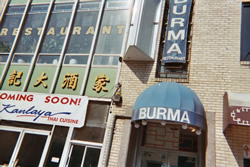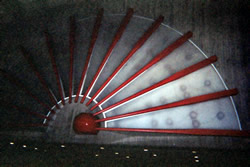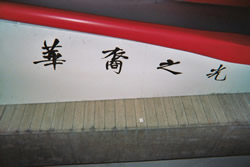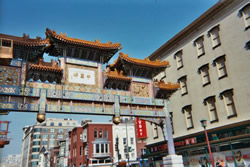Finding China
by Ann Morris
It would be nice if we all could visit Jackie Chan's birthplace Hong Kong and its parent, Mainland China, but most of us are not able to do that. Even though we can't travel to faraway China, there are quite a few ways we can explore China right here in the United States. If you live outside the United States, I'm sure there are places where you can find China too. I just have not had the chance to visit outside the U.S. and Mexico, so I can't point them out to you.
Within the U.S., there are quite a few cities that have "Chinatowns." In some, such as Washington, D.C., the "Chinatown" is merely a business district that is mostly restaurants. In some, such as in San Francisco, the area is quite large and not only is home to restaurants and shops but is also a place where people make their homes.
Even in cities where there is no specific area that you would call a "Chinatown," you'll find evidence of the Chinese culture. The biggest city near where I live is Tampa, Florida and though it hasn't got any one big Chinese neighborhood, there is a marvelous store called Oceanic Trading Company where you can find many interesting and amazing things. If you want Chinese or other Asian foods, cookers, utensils and items to decorate your home, this is the place to go. Not only can you find foods that come in jars and bottles but also they have fresh Chinese vegetables, fruits and meats. There are lots of smells that you don't find in your usual supermarket.
My husband likes to buy packages of noodles there and some of them haven't any English on them, so we have to guess at what kind of noodles they are and what the seasoning you add to them is. Because we don't know what's in the seasoning packets, it's a good idea to have a glass of water handy to put out the fire that some of them start in your mouth.
If you can't travel away from your home city, look in your phone book for Asian shops. You can find out a lot about people from visiting places where they shop.
It's also fun to go to Chinese restaurants and almost every town has at least one or two of these. Most will have forks, knives and spoons for you to eat with but they usually also give you chopsticks. Next time you get to eat at a Chinese restaurant, why don't you ask the server to show you how to hold chopsticks and then try eating your meal with them? It takes a little getting used to but you'll get the hang of it in not too long.

Just this past April, I got to take a trip to Washington, D.C. where my husband had a meeting to attend. I got to spend my time wandering around the city and visiting museums and I found a good bit of China there.
D.C.'s "Chinatown" is not very large. It was taken over recently by a big arena called the MCI Center. They have big indoor sports competitions there. I've seen ice skating championships on TV that were at the MCI Center. Even before the arena was built, it was not a place where many people lived. If you get a chance to visit D.C., and do want to see what there is of Chinatown, it's very easy to get to on the Metro system. The subway has a station called Gallery Plance/Chinatown. When you get to that station, you'll find that over the exit there is a big fan design on the wall and there are Chinese characters on the ceiling.


One of the things that remains of D.C.'s Chinatown is a large arch at the entrance to the area. This arch is named Friendship Arch and it was a project built with money from this country and Beijing. It's very ornate and quite pretty. The picture I took of it was taken in the early morning and there is a shadowy area because it was not in full light at the time. It's quite a large structure. You feel tiny standing near it. Even when you are far away, it looks huge.

Even though people don't live in this area, there are many who work there daily and as you walk along trying to decide which of the many restaurants you want to eat in, you can hear lots of conversations in Chinese. Since I don't speak any Chinese language, I cannot tell you if the people are speaking Cantonese, Jackie's first language, or Mandarin, which Jackie also speaks. Probably, both are spoken there and maybe some other dialects as well. (China has many different spoken languages, though the written language is the same throughout the country.)
There are two museums in D.C. that have a lot of Chinese items. They are the Sackler and Freer Galleries. They have some American items but are devoted mostly to Asian art and culture. Right now, there is a large exhibit at the Sackler Gallery devoted to statues of the Buddha that were discovered in Qingzhou, Shandong Province, in 1996.
Chinese workers who were working on a sports field accidentally uncovered a pit that was near what had been the location of the Longzing Buddhist Temple. In the pit they found hundreds of statues of the Buddha that dated from the sometime in the 500s A.D. They were buried between 1102 and 1107 A.D. They were broken but it is not known if they were broken before they were buried or if they were broken in the process of burying them. What makes them especially remarkable is their many styles and that there is still a large amount of pigment (paint) and gilt (gold & silver) left on them.
The exhibit at the Sackler Gallery features 35 of the sculptures. They range in size from about a foot high to about 6 or 7 feet high, I think. Some are quite elaborate but many are simple in style too. It is interesting to note that none of them is the fat man in just a loin cloth sitting with legs crossed Yoga style the we often see in TV, movies, or literature. The Chinese depiction of Buddha has a serene countenance (face), is slim, and is fully clothed. This is common to all the statues I saw, even though they differed in style.
You can find out more about the Buddha statues at the Smithsonian Institution website.
If you cannot go out to find China, you can use the Internet. If you are very young, I suggest you have an adult help you search.
Some interesting
sites that I have found are:
http://mandarintools.com.
You can get lots of information on Chinese culture here and get a Chinese
name.
http://www.chinasprout.com.
This is a shopping site but there is lots of information there too and a lot
of items for children. They have a lady you can write to for answers to questions
about Chinese life and culture. I've tried this and she answered very quickly.
Your school or public library is a good source to check out (get the joke?) for information on China and the Chinese people.
I've given you some ideas about finding China without being able to travel there. Now, why don't you share some of your ways to find China with the Kids Corner Webmaster? I'm sure everyone would love to know what you have discovered.
A Journey of
a thousand miles begins with one step.
Take that step.
Peace and love,
Ann Morris